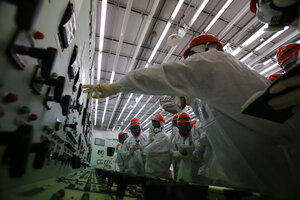Three years after Fukushima tragedy, Japan makes U-turn on nuclear energy
The terrible Fukushima nuclear accident has not stopped Japan from revamping its safety measures and restarting its nuclear reactors. Thirty-five years after its far less terrible Three Mile Island accident, the US still hesitates to embrace nuclear power

Members of the media and Tokyo Electric Power Co. (TEPCO) employees in protective suits and masks visit the central control room for the No. 1 and No. 2 reactors at the tsunami-crippled TEPCO's Fukushima Dai-ichi nuclear power plant. Despite the worst nuclear accident since Chernobyl, Japan is moving toward restarting several of its nuclear plants.
Toru Hanai/Pool/AP
Exactly three years ago, a tsunami wiped out Japan’s Fukushima Dai-ichi plant and in doing so, washed away the nation's confidence in nuclear power. But after three years of going almost nuclear-free, Japan has turned a corner – and appears headed back along a similar path as before the March 11, 2011, nuclear disaster.
On Monday, Prime Minister Shinzo Abe said nuclear power plants deemed safe by regulators would be restarted. By summer, the first of Japan’s idled nuclear plants could be operational – ones that would be located farthest away from the fault lines that triggered the offending earthquake and tsunami.
“I would forecast that of the 49 remaining units that half could come back over the next five years,” says Tom Drolet, a nuclear expert and consultant in Englewood, Fla., in an interview. “But no new nuclear units will be committed in the next 10 years because the Nuclear Regulation Authority is busy reviewing the return of existing units and because the public has to see that those will be successful.”
What's changed? Why is Japan returning to nuclear power three years after a terrible nuclear disaster while the fear generated by a much less dangerous nuclear accident – Three Mile Island – still hangs over the United States 35 years after it happened (also in March, coincidentally). Economics, Japan's long experience with the technology, even the threat of climate change play a role. Perhaps the biggest difference is Japan's lack of alternatives while the energy-rich US, far less reliant on nuclear power to begin with, had several options for creating power. America's embrace of nuclear power looks far less certain.
One factor that's helped Japan is a new nuclear watchdog. Created in September 2012, the Nuclear Regulation Authority has eliminated the cozy relationships that allowed utility employees to become nuclear regulators and it has stood up to political pressure to turn a blind eye to operational shortcuts.
The agency has shown its willingness to exert its influence: It routinely gives updates on the disabled Fukushima nuclear facility, cautioning that it has been leaking contaminated, or radiated, water into the Pacific Ocean. Tokyo Electric Power Co., which had operated the Fukushima facility, is now fully cooperating.
Then there are the economic costs. In May 2012, Japan turned off the last of its 54 nuclear reactors. Altogether, Japan has increased its reliance on imported liquefied natural gas to meet much of its electricity needs at a cost of more than $65 billion, says Deloitte Touch Tohmatsu. And the price of importing fossil fuels is getting even more expensive because of a weak yen.
With street protests to nix nuclear plants dying down and pleas to ease the economic pinch picking up, the pressure on politicians has changed, allowing them to propose a restart of nuclear power.
Then there's the capacity issue. The potential restart of Japan’s nuclear plants is within grasp in large measure because the infrastructure is in place and dismantling it would take decades.
Opponents of nuclear power argue that the way to avoid another disaster is to move on to cleaner energy. Adding renewables and energy efficiency measures would fulfill the energy promises in a cost-effective manner, they point out, noting that the country proved in the months following the nuclear crisis that it can reduce its energy consumption by as much as 15 percent.
Japan would like to raise its green energy mix from 9 percent today 21 percent by 2030. Major companies such as Toshiba, Hitachi and Mitsubishi are investing in wind, solar, and smart-grid technologies. Japan has been able to employ energy-efficiency methods resulting IN declines in consumption.
But the void left by the absence of nuclear power is just too great, nuclear proponents say. The country simply cannot replace 30 percent of its electric power generation overnight. The proponents add that all of the country’s nuclear reactors are going through rigorous new stress tests to ensure that they can survive massive natural events. They have a sympathetic ear in the Federation of American Scientists, which says that the accident at Fukushima was preventable – that the earthquake and tsunami there in 2011 were not unprecedented and were not unforeseeable.
Some climate scientists are also bolstering the case for nuclear, arguing that the risk of climate change is greater than the risk of a nuclear accident. Without nuclear energy, Japan for some time would have to rely on fossil fuels that will create more emissions.
If Japan is making its U-turn on nuclear three years after Fukushima, will the US embrace it 35 years after Three Mile Island? Activity is picking up, but old fears as well as recent reminders of nuclear-power challenges are preventing the rebirth of a legacy industry.

